Corporate Takeover Decision Making and Accounting: An Analysis
VerifiedAdded on 2020/12/18
|18
|3173
|232
Report
AI Summary
This report provides a comprehensive analysis of corporate takeover decision-making, focusing on the implications for consolidation accounting. It explores various acquisition strategies, comparing consolidation and equity accounting methods, and examines the application of relevant Australian Accounting Standards (AASB), including AASB 3, AASB 10, AASB 127, and AASB 128. The report delves into the treatment of intra-group transactions, emphasizing the elimination of such transactions during consolidation. Furthermore, it investigates the impact of non-controlling interest (NCI) disclosure requirements on the consolidation process, highlighting how NCI is presented in the consolidated financial statements. The report uses a case study of JKY Ltd and FAB Ltd to illustrate the practical application of these accounting principles, offering insights into the recognition and measurement of assets, liabilities, and goodwill in business combinations. The report concludes by summarizing the key findings and recommendations for effective corporate takeover decision-making and financial reporting.

Corporate Takeover Decision Making and the
Effects on consolidation Accounting
Effects on consolidation Accounting
Paraphrase This Document
Need a fresh take? Get an instant paraphrase of this document with our AI Paraphraser
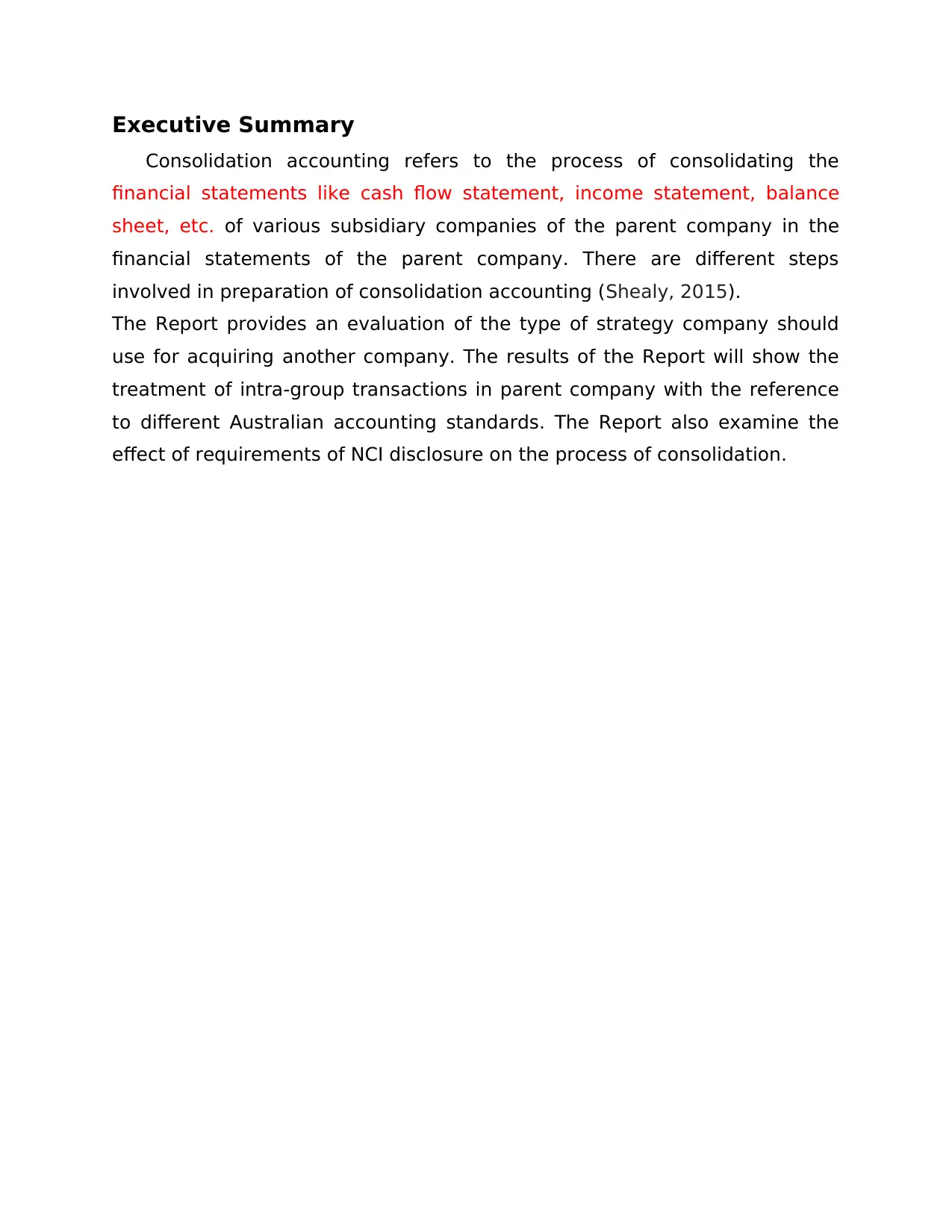
Executive Summary
Consolidation accounting refers to the process of consolidating the
financial statements like cash flow statement, income statement, balance
sheet, etc. of various subsidiary companies of the parent company in the
financial statements of the parent company. There are different steps
involved in preparation of consolidation accounting (Shealy, 2015).
The Report provides an evaluation of the type of strategy company should
use for acquiring another company. The results of the Report will show the
treatment of intra-group transactions in parent company with the reference
to different Australian accounting standards. The Report also examine the
effect of requirements of NCI disclosure on the process of consolidation.
Consolidation accounting refers to the process of consolidating the
financial statements like cash flow statement, income statement, balance
sheet, etc. of various subsidiary companies of the parent company in the
financial statements of the parent company. There are different steps
involved in preparation of consolidation accounting (Shealy, 2015).
The Report provides an evaluation of the type of strategy company should
use for acquiring another company. The results of the Report will show the
treatment of intra-group transactions in parent company with the reference
to different Australian accounting standards. The Report also examine the
effect of requirements of NCI disclosure on the process of consolidation.
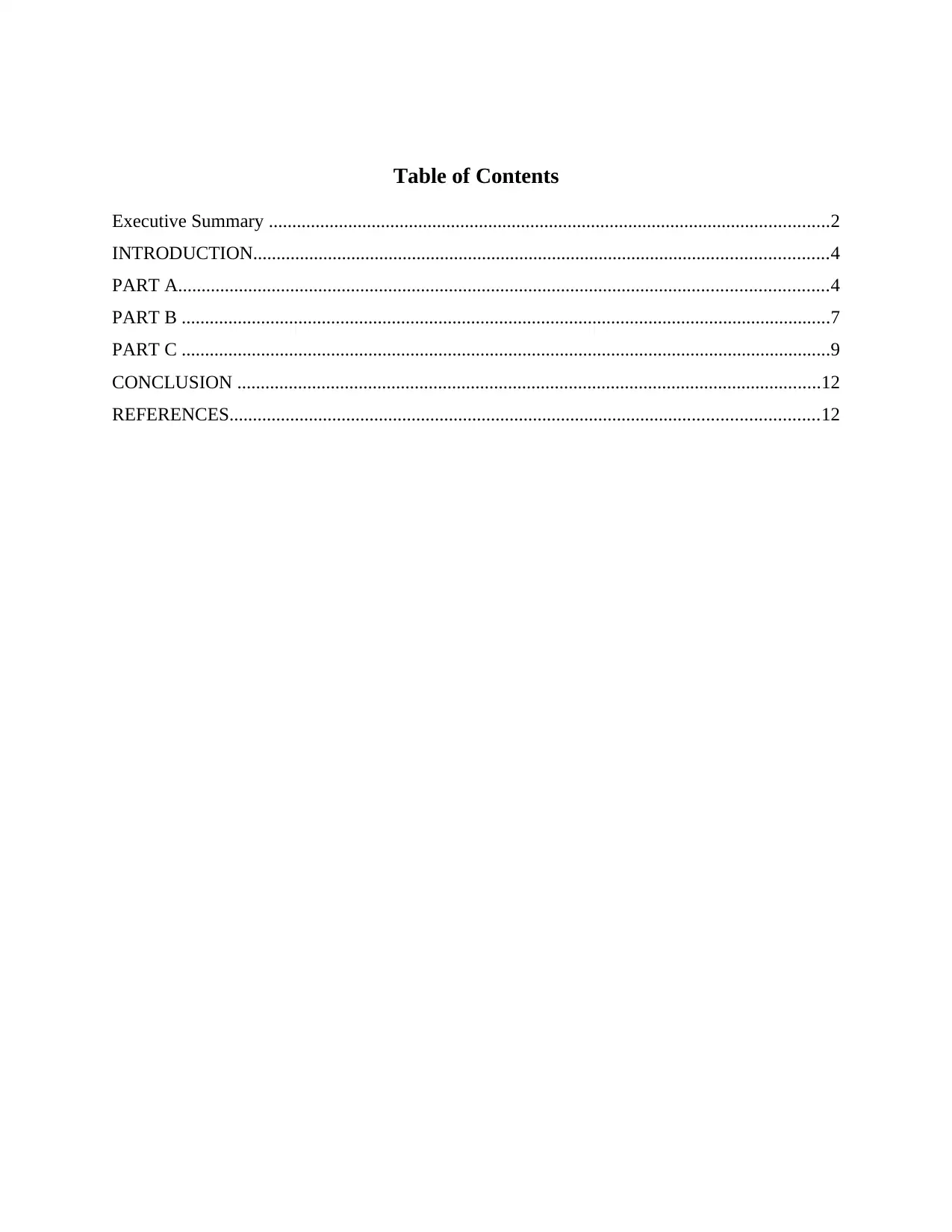
Table of Contents
Executive Summary ........................................................................................................................2
INTRODUCTION...........................................................................................................................4
PART A...........................................................................................................................................4
PART B ...........................................................................................................................................7
PART C ...........................................................................................................................................9
CONCLUSION .............................................................................................................................12
REFERENCES..............................................................................................................................12
Executive Summary ........................................................................................................................2
INTRODUCTION...........................................................................................................................4
PART A...........................................................................................................................................4
PART B ...........................................................................................................................................7
PART C ...........................................................................................................................................9
CONCLUSION .............................................................................................................................12
REFERENCES..............................................................................................................................12
⊘ This is a preview!⊘
Do you want full access?
Subscribe today to unlock all pages.

Trusted by 1+ million students worldwide
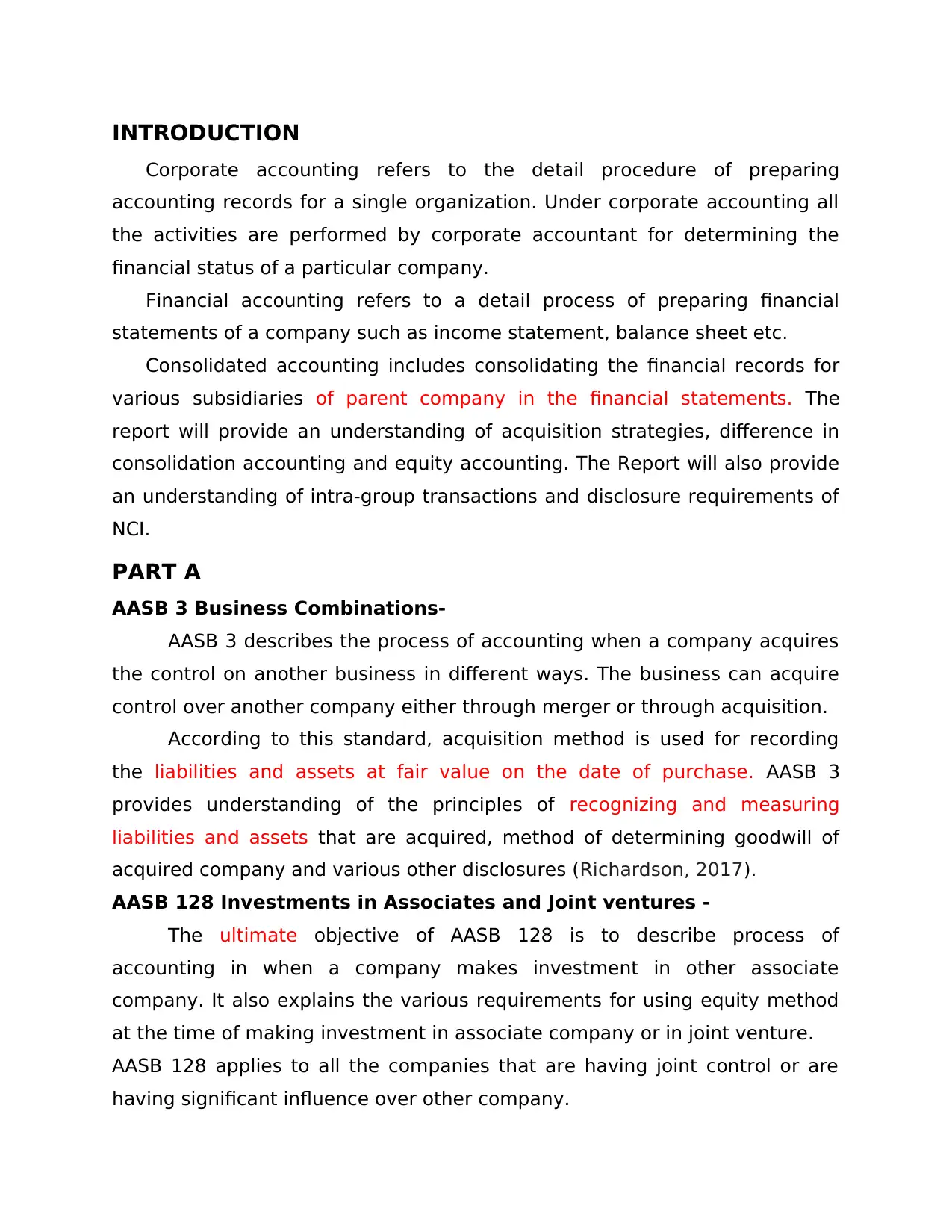
INTRODUCTION
Corporate accounting refers to the detail procedure of preparing
accounting records for a single organization. Under corporate accounting all
the activities are performed by corporate accountant for determining the
financial status of a particular company.
Financial accounting refers to a detail process of preparing financial
statements of a company such as income statement, balance sheet etc.
Consolidated accounting includes consolidating the financial records for
various subsidiaries of parent company in the financial statements. The
report will provide an understanding of acquisition strategies, difference in
consolidation accounting and equity accounting. The Report will also provide
an understanding of intra-group transactions and disclosure requirements of
NCI.
PART A
AASB 3 Business Combinations-
AASB 3 describes the process of accounting when a company acquires
the control on another business in different ways. The business can acquire
control over another company either through merger or through acquisition.
According to this standard, acquisition method is used for recording
the liabilities and assets at fair value on the date of purchase. AASB 3
provides understanding of the principles of recognizing and measuring
liabilities and assets that are acquired, method of determining goodwill of
acquired company and various other disclosures (Richardson, 2017).
AASB 128 Investments in Associates and Joint ventures -
The ultimate objective of AASB 128 is to describe process of
accounting in when a company makes investment in other associate
company. It also explains the various requirements for using equity method
at the time of making investment in associate company or in joint venture.
AASB 128 applies to all the companies that are having joint control or are
having significant influence over other company.
Corporate accounting refers to the detail procedure of preparing
accounting records for a single organization. Under corporate accounting all
the activities are performed by corporate accountant for determining the
financial status of a particular company.
Financial accounting refers to a detail process of preparing financial
statements of a company such as income statement, balance sheet etc.
Consolidated accounting includes consolidating the financial records for
various subsidiaries of parent company in the financial statements. The
report will provide an understanding of acquisition strategies, difference in
consolidation accounting and equity accounting. The Report will also provide
an understanding of intra-group transactions and disclosure requirements of
NCI.
PART A
AASB 3 Business Combinations-
AASB 3 describes the process of accounting when a company acquires
the control on another business in different ways. The business can acquire
control over another company either through merger or through acquisition.
According to this standard, acquisition method is used for recording
the liabilities and assets at fair value on the date of purchase. AASB 3
provides understanding of the principles of recognizing and measuring
liabilities and assets that are acquired, method of determining goodwill of
acquired company and various other disclosures (Richardson, 2017).
AASB 128 Investments in Associates and Joint ventures -
The ultimate objective of AASB 128 is to describe process of
accounting in when a company makes investment in other associate
company. It also explains the various requirements for using equity method
at the time of making investment in associate company or in joint venture.
AASB 128 applies to all the companies that are having joint control or are
having significant influence over other company.
Paraphrase This Document
Need a fresh take? Get an instant paraphrase of this document with our AI Paraphraser
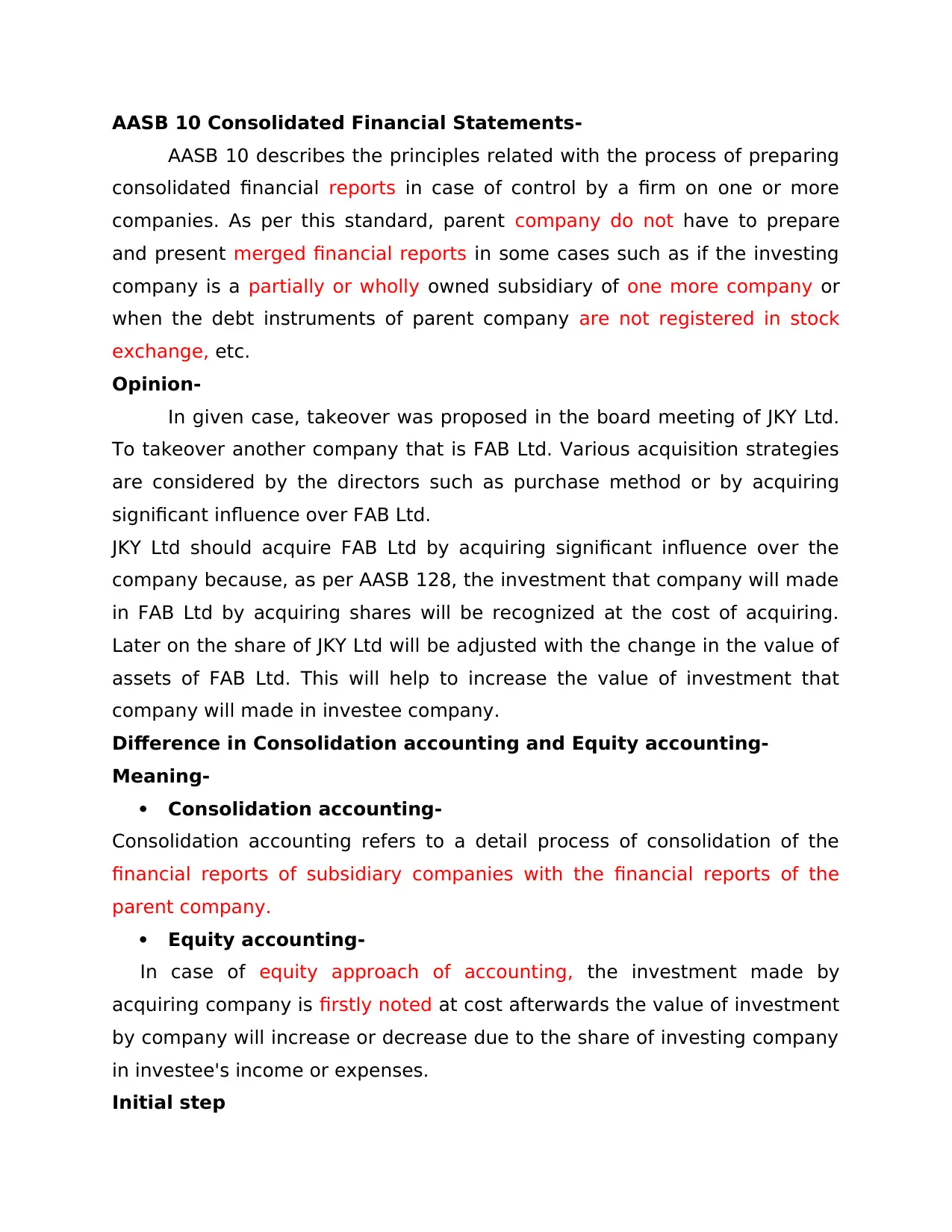
AASB 10 Consolidated Financial Statements-
AASB 10 describes the principles related with the process of preparing
consolidated financial reports in case of control by a firm on one or more
companies. As per this standard, parent company do not have to prepare
and present merged financial reports in some cases such as if the investing
company is a partially or wholly owned subsidiary of one more company or
when the debt instruments of parent company are not registered in stock
exchange, etc.
Opinion-
In given case, takeover was proposed in the board meeting of JKY Ltd.
To takeover another company that is FAB Ltd. Various acquisition strategies
are considered by the directors such as purchase method or by acquiring
significant influence over FAB Ltd.
JKY Ltd should acquire FAB Ltd by acquiring significant influence over the
company because, as per AASB 128, the investment that company will made
in FAB Ltd by acquiring shares will be recognized at the cost of acquiring.
Later on the share of JKY Ltd will be adjusted with the change in the value of
assets of FAB Ltd. This will help to increase the value of investment that
company will made in investee company.
Difference in Consolidation accounting and Equity accounting-
Meaning-
Consolidation accounting-
Consolidation accounting refers to a detail process of consolidation of the
financial reports of subsidiary companies with the financial reports of the
parent company.
Equity accounting-
In case of equity approach of accounting, the investment made by
acquiring company is firstly noted at cost afterwards the value of investment
by company will increase or decrease due to the share of investing company
in investee's income or expenses.
Initial step
AASB 10 describes the principles related with the process of preparing
consolidated financial reports in case of control by a firm on one or more
companies. As per this standard, parent company do not have to prepare
and present merged financial reports in some cases such as if the investing
company is a partially or wholly owned subsidiary of one more company or
when the debt instruments of parent company are not registered in stock
exchange, etc.
Opinion-
In given case, takeover was proposed in the board meeting of JKY Ltd.
To takeover another company that is FAB Ltd. Various acquisition strategies
are considered by the directors such as purchase method or by acquiring
significant influence over FAB Ltd.
JKY Ltd should acquire FAB Ltd by acquiring significant influence over the
company because, as per AASB 128, the investment that company will made
in FAB Ltd by acquiring shares will be recognized at the cost of acquiring.
Later on the share of JKY Ltd will be adjusted with the change in the value of
assets of FAB Ltd. This will help to increase the value of investment that
company will made in investee company.
Difference in Consolidation accounting and Equity accounting-
Meaning-
Consolidation accounting-
Consolidation accounting refers to a detail process of consolidation of the
financial reports of subsidiary companies with the financial reports of the
parent company.
Equity accounting-
In case of equity approach of accounting, the investment made by
acquiring company is firstly noted at cost afterwards the value of investment
by company will increase or decrease due to the share of investing company
in investee's income or expenses.
Initial step
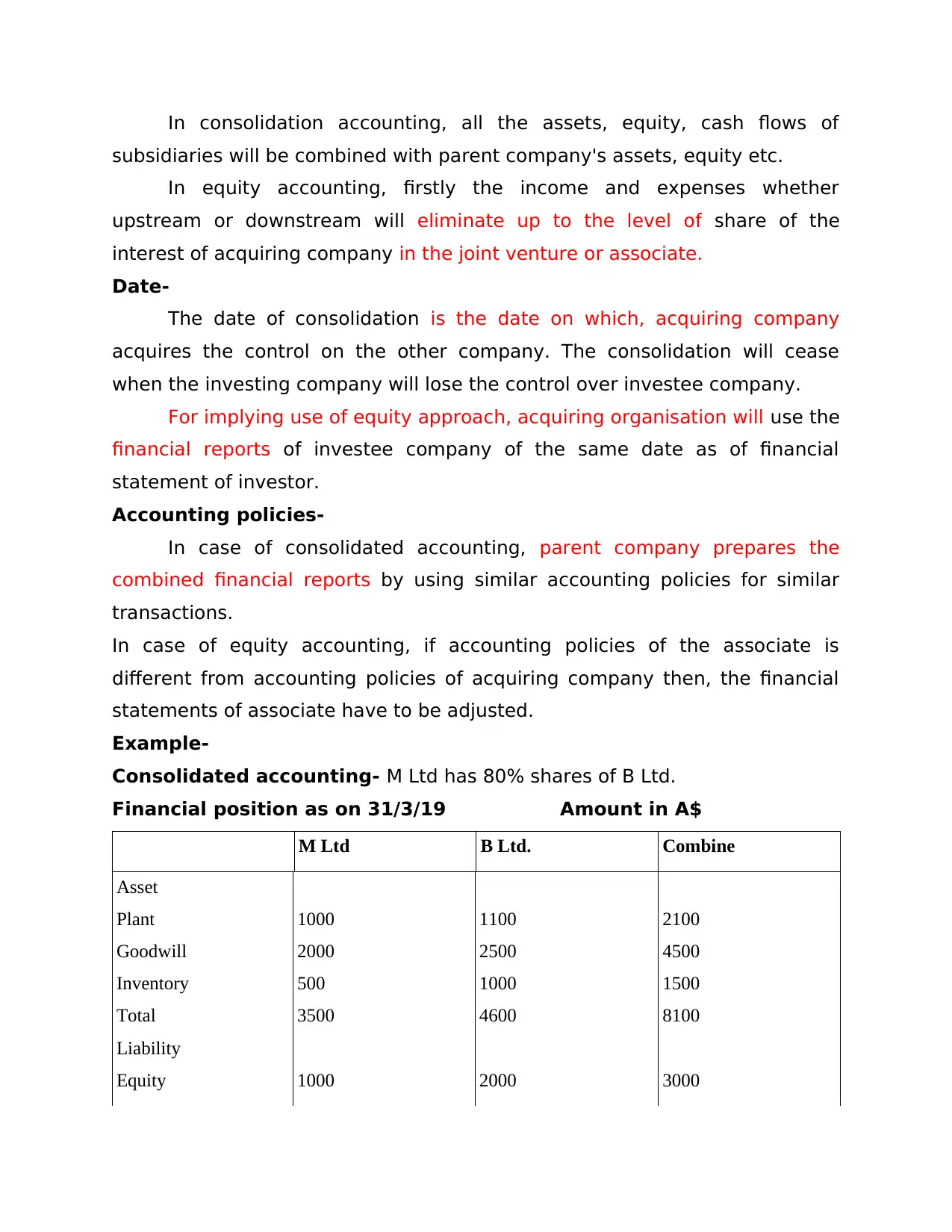
In consolidation accounting, all the assets, equity, cash flows of
subsidiaries will be combined with parent company's assets, equity etc.
In equity accounting, firstly the income and expenses whether
upstream or downstream will eliminate up to the level of share of the
interest of acquiring company in the joint venture or associate.
Date-
The date of consolidation is the date on which, acquiring company
acquires the control on the other company. The consolidation will cease
when the investing company will lose the control over investee company.
For implying use of equity approach, acquiring organisation will use the
financial reports of investee company of the same date as of financial
statement of investor.
Accounting policies-
In case of consolidated accounting, parent company prepares the
combined financial reports by using similar accounting policies for similar
transactions.
In case of equity accounting, if accounting policies of the associate is
different from accounting policies of acquiring company then, the financial
statements of associate have to be adjusted.
Example-
Consolidated accounting- M Ltd has 80% shares of B Ltd.
Financial position as on 31/3/19 Amount in A$
M Ltd B Ltd. Combine
Asset
Plant
Goodwill
Inventory
Total
Liability
Equity
1000
2000
500
3500
1000
1100
2500
1000
4600
2000
2100
4500
1500
8100
3000
subsidiaries will be combined with parent company's assets, equity etc.
In equity accounting, firstly the income and expenses whether
upstream or downstream will eliminate up to the level of share of the
interest of acquiring company in the joint venture or associate.
Date-
The date of consolidation is the date on which, acquiring company
acquires the control on the other company. The consolidation will cease
when the investing company will lose the control over investee company.
For implying use of equity approach, acquiring organisation will use the
financial reports of investee company of the same date as of financial
statement of investor.
Accounting policies-
In case of consolidated accounting, parent company prepares the
combined financial reports by using similar accounting policies for similar
transactions.
In case of equity accounting, if accounting policies of the associate is
different from accounting policies of acquiring company then, the financial
statements of associate have to be adjusted.
Example-
Consolidated accounting- M Ltd has 80% shares of B Ltd.
Financial position as on 31/3/19 Amount in A$
M Ltd B Ltd. Combine
Asset
Plant
Goodwill
Inventory
Total
Liability
Equity
1000
2000
500
3500
1000
1100
2500
1000
4600
2000
2100
4500
1500
8100
3000
⊘ This is a preview!⊘
Do you want full access?
Subscribe today to unlock all pages.

Trusted by 1+ million students worldwide
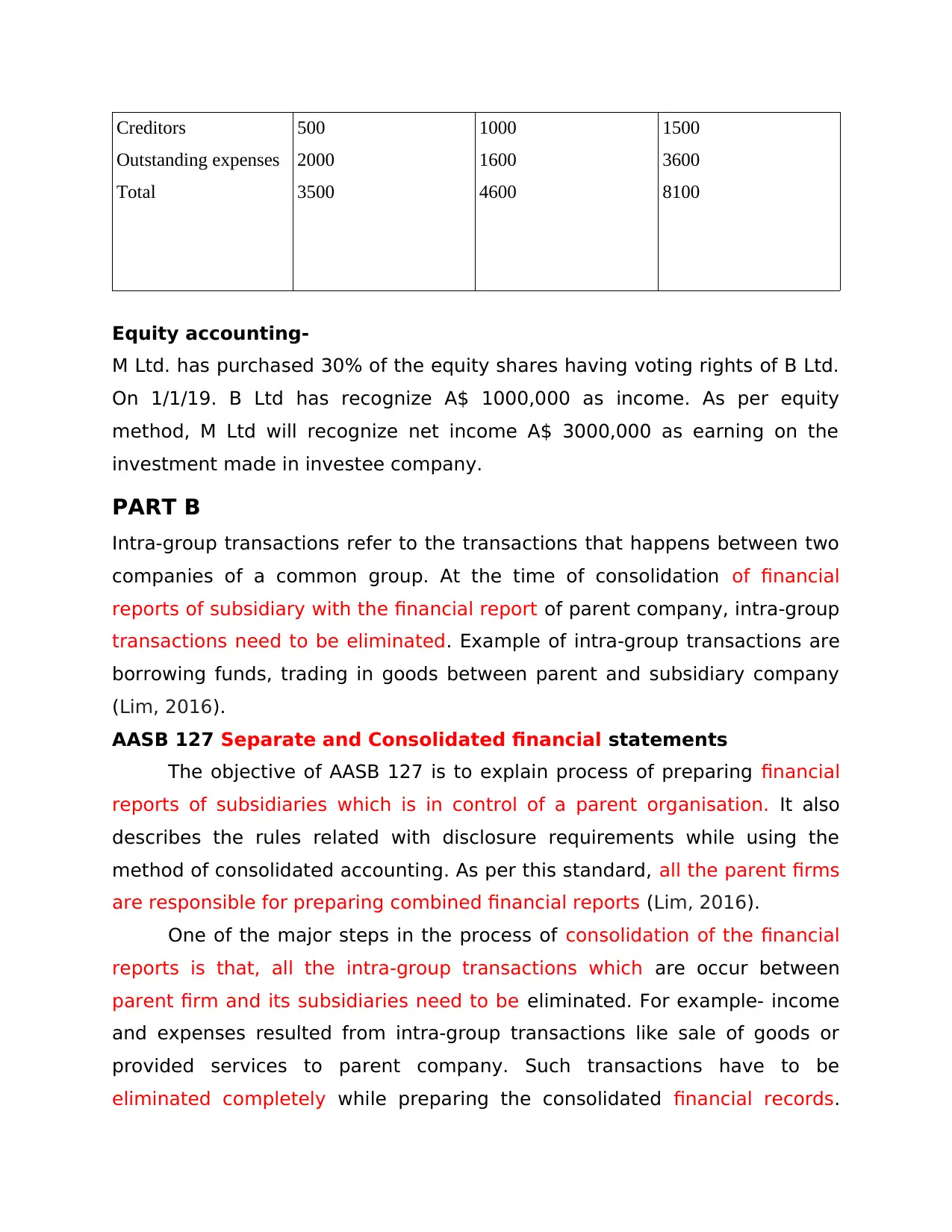
Creditors
Outstanding expenses
Total
500
2000
3500
1000
1600
4600
1500
3600
8100
Equity accounting-
M Ltd. has purchased 30% of the equity shares having voting rights of B Ltd.
On 1/1/19. B Ltd has recognize A$ 1000,000 as income. As per equity
method, M Ltd will recognize net income A$ 3000,000 as earning on the
investment made in investee company.
PART B
Intra-group transactions refer to the transactions that happens between two
companies of a common group. At the time of consolidation of financial
reports of subsidiary with the financial report of parent company, intra-group
transactions need to be eliminated. Example of intra-group transactions are
borrowing funds, trading in goods between parent and subsidiary company
(Lim, 2016).
AASB 127 Separate and Consolidated financial statements
The objective of AASB 127 is to explain process of preparing financial
reports of subsidiaries which is in control of a parent organisation. It also
describes the rules related with disclosure requirements while using the
method of consolidated accounting. As per this standard, all the parent firms
are responsible for preparing combined financial reports (Lim, 2016).
One of the major steps in the process of consolidation of the financial
reports is that, all the intra-group transactions which are occur between
parent firm and its subsidiaries need to be eliminated. For example- income
and expenses resulted from intra-group transactions like sale of goods or
provided services to parent company. Such transactions have to be
eliminated completely while preparing the consolidated financial records.
Outstanding expenses
Total
500
2000
3500
1000
1600
4600
1500
3600
8100
Equity accounting-
M Ltd. has purchased 30% of the equity shares having voting rights of B Ltd.
On 1/1/19. B Ltd has recognize A$ 1000,000 as income. As per equity
method, M Ltd will recognize net income A$ 3000,000 as earning on the
investment made in investee company.
PART B
Intra-group transactions refer to the transactions that happens between two
companies of a common group. At the time of consolidation of financial
reports of subsidiary with the financial report of parent company, intra-group
transactions need to be eliminated. Example of intra-group transactions are
borrowing funds, trading in goods between parent and subsidiary company
(Lim, 2016).
AASB 127 Separate and Consolidated financial statements
The objective of AASB 127 is to explain process of preparing financial
reports of subsidiaries which is in control of a parent organisation. It also
describes the rules related with disclosure requirements while using the
method of consolidated accounting. As per this standard, all the parent firms
are responsible for preparing combined financial reports (Lim, 2016).
One of the major steps in the process of consolidation of the financial
reports is that, all the intra-group transactions which are occur between
parent firm and its subsidiaries need to be eliminated. For example- income
and expenses resulted from intra-group transactions like sale of goods or
provided services to parent company. Such transactions have to be
eliminated completely while preparing the consolidated financial records.
Paraphrase This Document
Need a fresh take? Get an instant paraphrase of this document with our AI Paraphraser
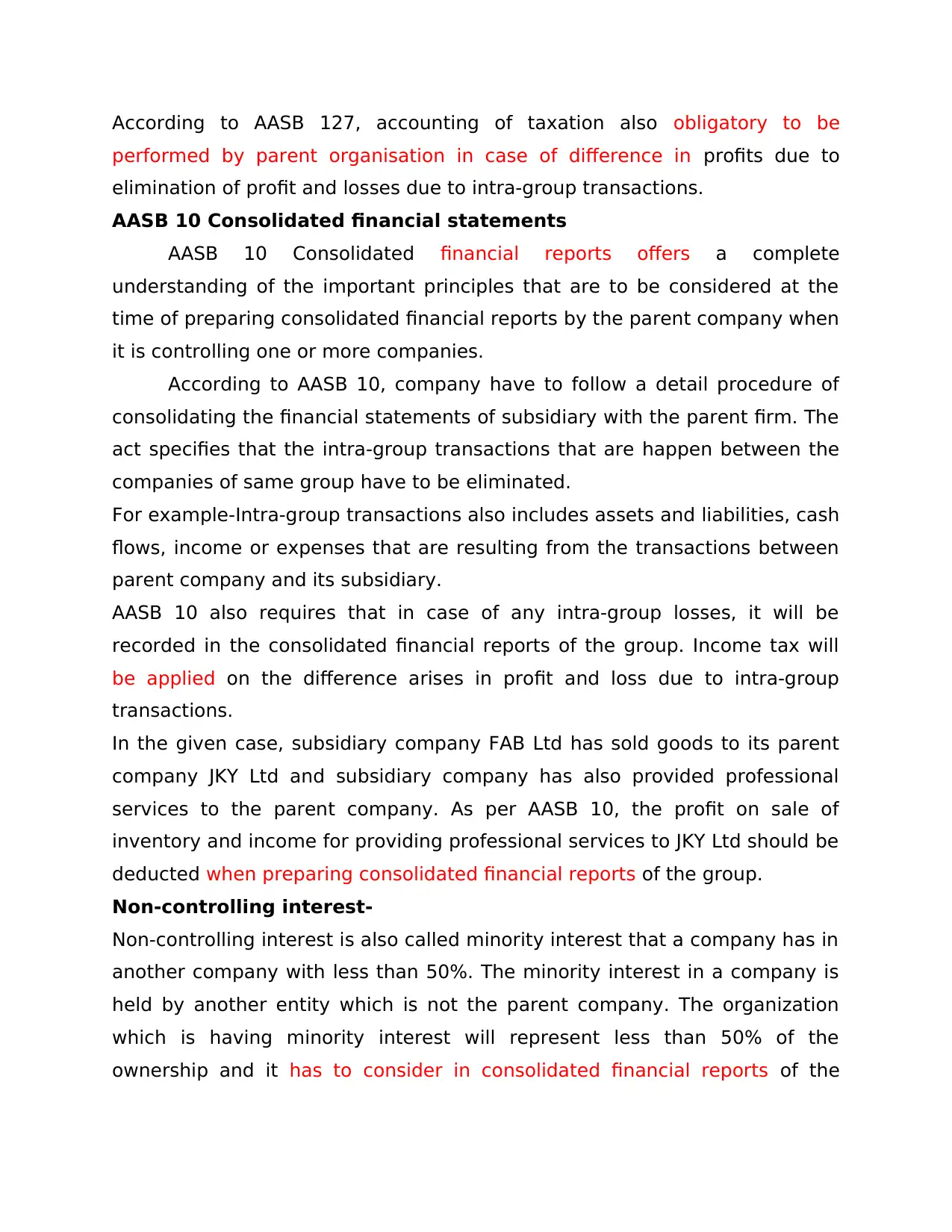
According to AASB 127, accounting of taxation also obligatory to be
performed by parent organisation in case of difference in profits due to
elimination of profit and losses due to intra-group transactions.
AASB 10 Consolidated financial statements
AASB 10 Consolidated financial reports offers a complete
understanding of the important principles that are to be considered at the
time of preparing consolidated financial reports by the parent company when
it is controlling one or more companies.
According to AASB 10, company have to follow a detail procedure of
consolidating the financial statements of subsidiary with the parent firm. The
act specifies that the intra-group transactions that are happen between the
companies of same group have to be eliminated.
For example-Intra-group transactions also includes assets and liabilities, cash
flows, income or expenses that are resulting from the transactions between
parent company and its subsidiary.
AASB 10 also requires that in case of any intra-group losses, it will be
recorded in the consolidated financial reports of the group. Income tax will
be applied on the difference arises in profit and loss due to intra-group
transactions.
In the given case, subsidiary company FAB Ltd has sold goods to its parent
company JKY Ltd and subsidiary company has also provided professional
services to the parent company. As per AASB 10, the profit on sale of
inventory and income for providing professional services to JKY Ltd should be
deducted when preparing consolidated financial reports of the group.
Non-controlling interest-
Non-controlling interest is also called minority interest that a company has in
another company with less than 50%. The minority interest in a company is
held by another entity which is not the parent company. The organization
which is having minority interest will represent less than 50% of the
ownership and it has to consider in consolidated financial reports of the
performed by parent organisation in case of difference in profits due to
elimination of profit and losses due to intra-group transactions.
AASB 10 Consolidated financial statements
AASB 10 Consolidated financial reports offers a complete
understanding of the important principles that are to be considered at the
time of preparing consolidated financial reports by the parent company when
it is controlling one or more companies.
According to AASB 10, company have to follow a detail procedure of
consolidating the financial statements of subsidiary with the parent firm. The
act specifies that the intra-group transactions that are happen between the
companies of same group have to be eliminated.
For example-Intra-group transactions also includes assets and liabilities, cash
flows, income or expenses that are resulting from the transactions between
parent company and its subsidiary.
AASB 10 also requires that in case of any intra-group losses, it will be
recorded in the consolidated financial reports of the group. Income tax will
be applied on the difference arises in profit and loss due to intra-group
transactions.
In the given case, subsidiary company FAB Ltd has sold goods to its parent
company JKY Ltd and subsidiary company has also provided professional
services to the parent company. As per AASB 10, the profit on sale of
inventory and income for providing professional services to JKY Ltd should be
deducted when preparing consolidated financial reports of the group.
Non-controlling interest-
Non-controlling interest is also called minority interest that a company has in
another company with less than 50%. The minority interest in a company is
held by another entity which is not the parent company. The organization
which is having minority interest will represent less than 50% of the
ownership and it has to consider in consolidated financial reports of the
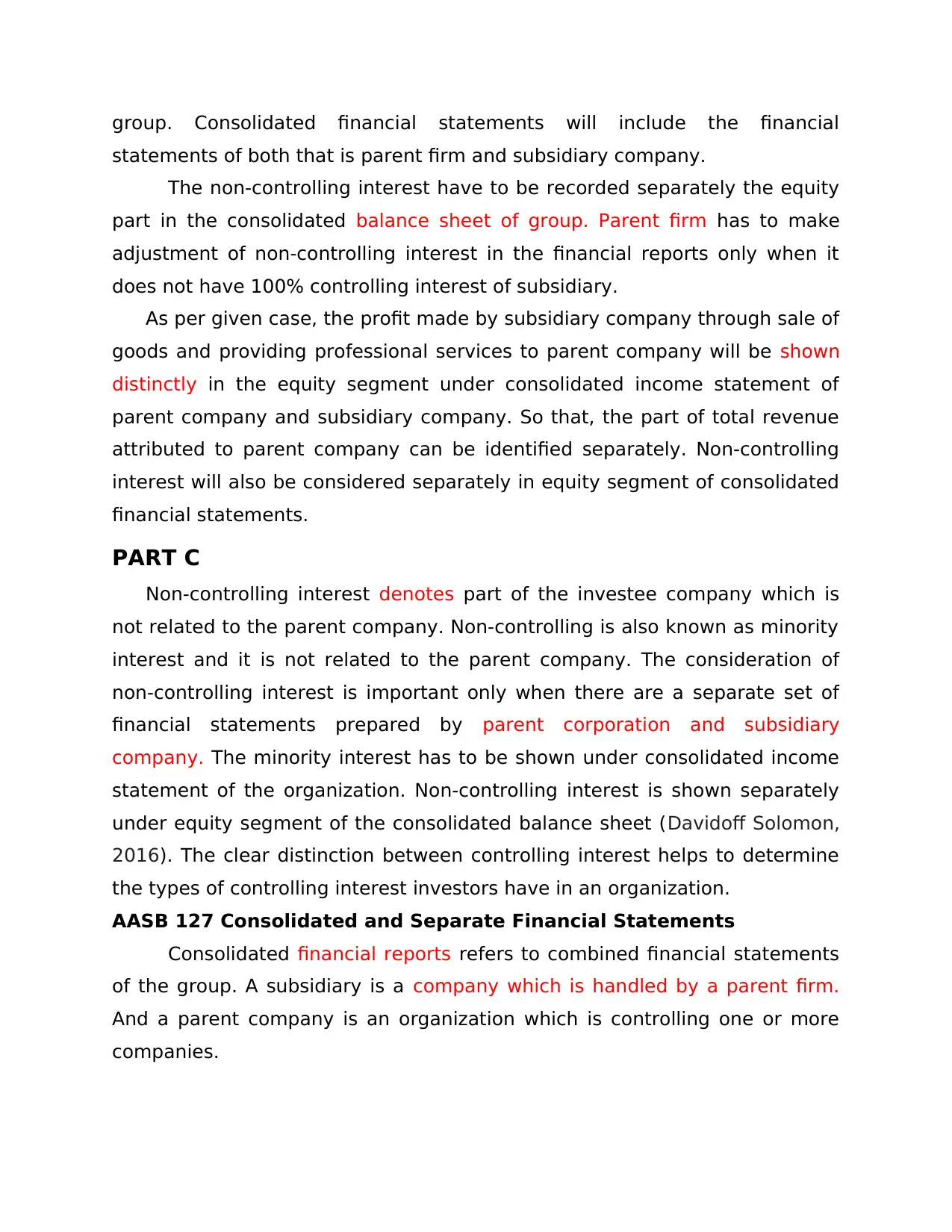
group. Consolidated financial statements will include the financial
statements of both that is parent firm and subsidiary company.
The non-controlling interest have to be recorded separately the equity
part in the consolidated balance sheet of group. Parent firm has to make
adjustment of non-controlling interest in the financial reports only when it
does not have 100% controlling interest of subsidiary.
As per given case, the profit made by subsidiary company through sale of
goods and providing professional services to parent company will be shown
distinctly in the equity segment under consolidated income statement of
parent company and subsidiary company. So that, the part of total revenue
attributed to parent company can be identified separately. Non-controlling
interest will also be considered separately in equity segment of consolidated
financial statements.
PART C
Non-controlling interest denotes part of the investee company which is
not related to the parent company. Non-controlling is also known as minority
interest and it is not related to the parent company. The consideration of
non-controlling interest is important only when there are a separate set of
financial statements prepared by parent corporation and subsidiary
company. The minority interest has to be shown under consolidated income
statement of the organization. Non-controlling interest is shown separately
under equity segment of the consolidated balance sheet (Davidoff Solomon,
2016). The clear distinction between controlling interest helps to determine
the types of controlling interest investors have in an organization.
AASB 127 Consolidated and Separate Financial Statements
Consolidated financial reports refers to combined financial statements
of the group. A subsidiary is a company which is handled by a parent firm.
And a parent company is an organization which is controlling one or more
companies.
statements of both that is parent firm and subsidiary company.
The non-controlling interest have to be recorded separately the equity
part in the consolidated balance sheet of group. Parent firm has to make
adjustment of non-controlling interest in the financial reports only when it
does not have 100% controlling interest of subsidiary.
As per given case, the profit made by subsidiary company through sale of
goods and providing professional services to parent company will be shown
distinctly in the equity segment under consolidated income statement of
parent company and subsidiary company. So that, the part of total revenue
attributed to parent company can be identified separately. Non-controlling
interest will also be considered separately in equity segment of consolidated
financial statements.
PART C
Non-controlling interest denotes part of the investee company which is
not related to the parent company. Non-controlling is also known as minority
interest and it is not related to the parent company. The consideration of
non-controlling interest is important only when there are a separate set of
financial statements prepared by parent corporation and subsidiary
company. The minority interest has to be shown under consolidated income
statement of the organization. Non-controlling interest is shown separately
under equity segment of the consolidated balance sheet (Davidoff Solomon,
2016). The clear distinction between controlling interest helps to determine
the types of controlling interest investors have in an organization.
AASB 127 Consolidated and Separate Financial Statements
Consolidated financial reports refers to combined financial statements
of the group. A subsidiary is a company which is handled by a parent firm.
And a parent company is an organization which is controlling one or more
companies.
⊘ This is a preview!⊘
Do you want full access?
Subscribe today to unlock all pages.

Trusted by 1+ million students worldwide
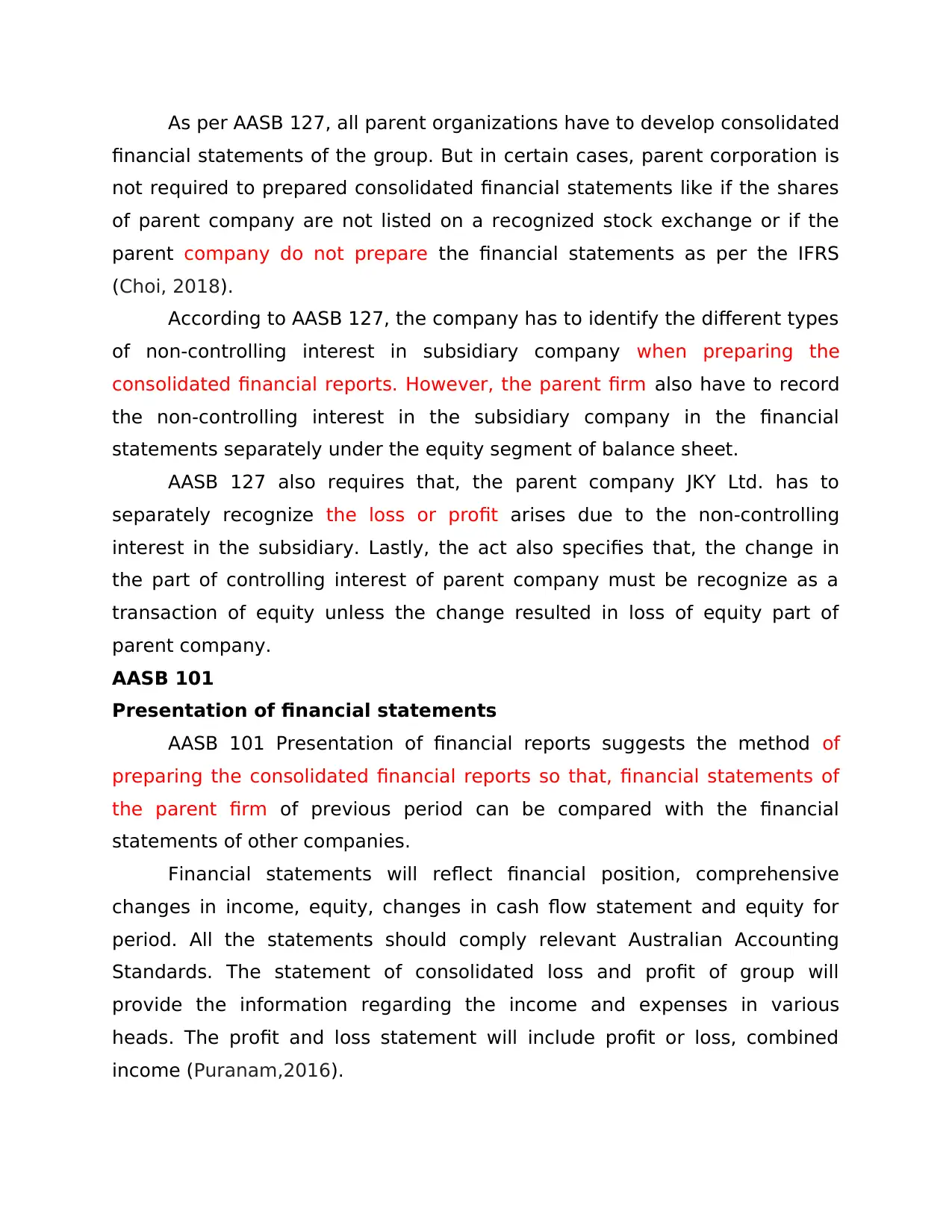
As per AASB 127, all parent organizations have to develop consolidated
financial statements of the group. But in certain cases, parent corporation is
not required to prepared consolidated financial statements like if the shares
of parent company are not listed on a recognized stock exchange or if the
parent company do not prepare the financial statements as per the IFRS
(Choi, 2018).
According to AASB 127, the company has to identify the different types
of non-controlling interest in subsidiary company when preparing the
consolidated financial reports. However, the parent firm also have to record
the non-controlling interest in the subsidiary company in the financial
statements separately under the equity segment of balance sheet.
AASB 127 also requires that, the parent company JKY Ltd. has to
separately recognize the loss or profit arises due to the non-controlling
interest in the subsidiary. Lastly, the act also specifies that, the change in
the part of controlling interest of parent company must be recognize as a
transaction of equity unless the change resulted in loss of equity part of
parent company.
AASB 101
Presentation of financial statements
AASB 101 Presentation of financial reports suggests the method of
preparing the consolidated financial reports so that, financial statements of
the parent firm of previous period can be compared with the financial
statements of other companies.
Financial statements will reflect financial position, comprehensive
changes in income, equity, changes in cash flow statement and equity for
period. All the statements should comply relevant Australian Accounting
Standards. The statement of consolidated loss and profit of group will
provide the information regarding the income and expenses in various
heads. The profit and loss statement will include profit or loss, combined
income (Puranam,2016).
financial statements of the group. But in certain cases, parent corporation is
not required to prepared consolidated financial statements like if the shares
of parent company are not listed on a recognized stock exchange or if the
parent company do not prepare the financial statements as per the IFRS
(Choi, 2018).
According to AASB 127, the company has to identify the different types
of non-controlling interest in subsidiary company when preparing the
consolidated financial reports. However, the parent firm also have to record
the non-controlling interest in the subsidiary company in the financial
statements separately under the equity segment of balance sheet.
AASB 127 also requires that, the parent company JKY Ltd. has to
separately recognize the loss or profit arises due to the non-controlling
interest in the subsidiary. Lastly, the act also specifies that, the change in
the part of controlling interest of parent company must be recognize as a
transaction of equity unless the change resulted in loss of equity part of
parent company.
AASB 101
Presentation of financial statements
AASB 101 Presentation of financial reports suggests the method of
preparing the consolidated financial reports so that, financial statements of
the parent firm of previous period can be compared with the financial
statements of other companies.
Financial statements will reflect financial position, comprehensive
changes in income, equity, changes in cash flow statement and equity for
period. All the statements should comply relevant Australian Accounting
Standards. The statement of consolidated loss and profit of group will
provide the information regarding the income and expenses in various
heads. The profit and loss statement will include profit or loss, combined
income (Puranam,2016).
Paraphrase This Document
Need a fresh take? Get an instant paraphrase of this document with our AI Paraphraser
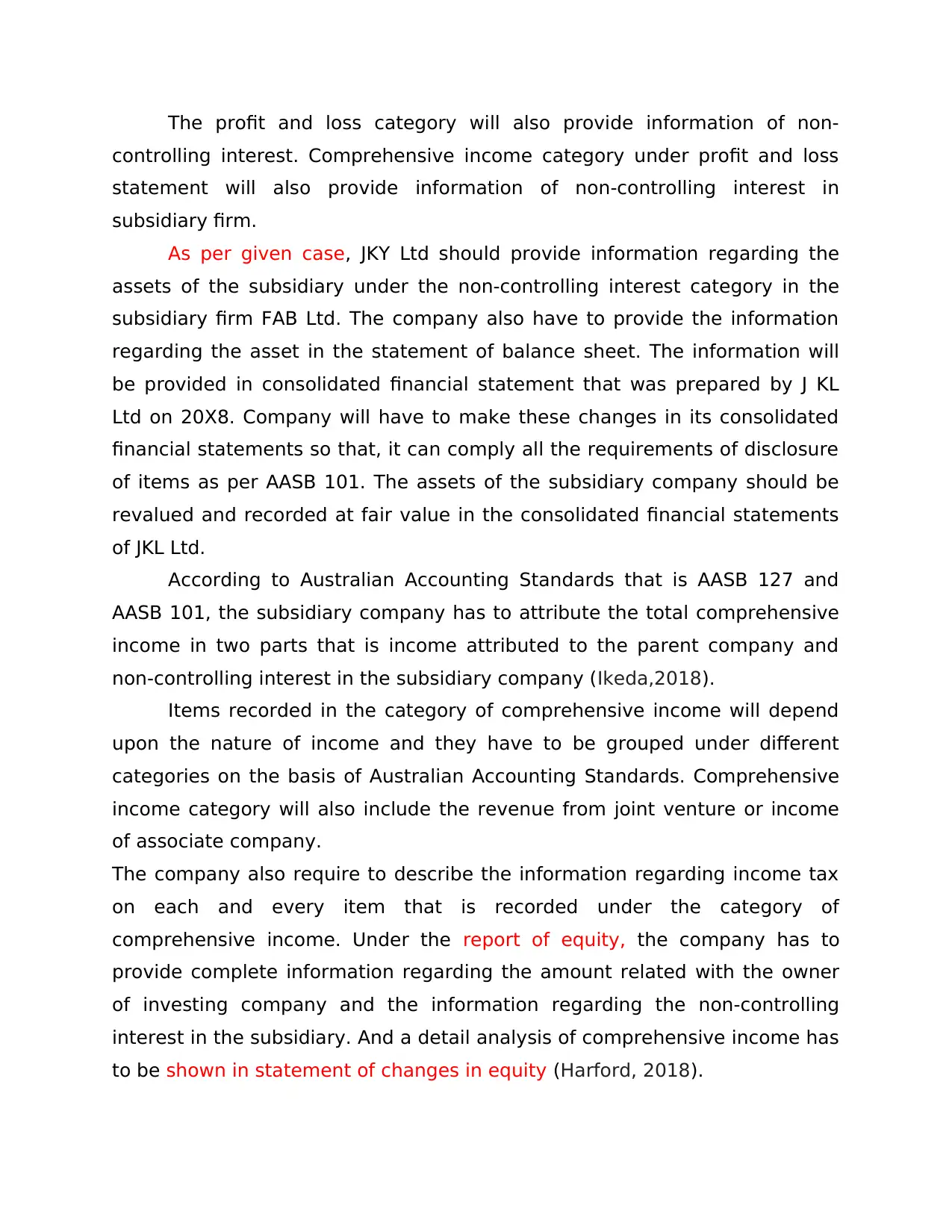
The profit and loss category will also provide information of non-
controlling interest. Comprehensive income category under profit and loss
statement will also provide information of non-controlling interest in
subsidiary firm.
As per given case, JKY Ltd should provide information regarding the
assets of the subsidiary under the non-controlling interest category in the
subsidiary firm FAB Ltd. The company also have to provide the information
regarding the asset in the statement of balance sheet. The information will
be provided in consolidated financial statement that was prepared by J KL
Ltd on 20X8. Company will have to make these changes in its consolidated
financial statements so that, it can comply all the requirements of disclosure
of items as per AASB 101. The assets of the subsidiary company should be
revalued and recorded at fair value in the consolidated financial statements
of JKL Ltd.
According to Australian Accounting Standards that is AASB 127 and
AASB 101, the subsidiary company has to attribute the total comprehensive
income in two parts that is income attributed to the parent company and
non-controlling interest in the subsidiary company (Ikeda,2018).
Items recorded in the category of comprehensive income will depend
upon the nature of income and they have to be grouped under different
categories on the basis of Australian Accounting Standards. Comprehensive
income category will also include the revenue from joint venture or income
of associate company.
The company also require to describe the information regarding income tax
on each and every item that is recorded under the category of
comprehensive income. Under the report of equity, the company has to
provide complete information regarding the amount related with the owner
of investing company and the information regarding the non-controlling
interest in the subsidiary. And a detail analysis of comprehensive income has
to be shown in statement of changes in equity (Harford, 2018).
controlling interest. Comprehensive income category under profit and loss
statement will also provide information of non-controlling interest in
subsidiary firm.
As per given case, JKY Ltd should provide information regarding the
assets of the subsidiary under the non-controlling interest category in the
subsidiary firm FAB Ltd. The company also have to provide the information
regarding the asset in the statement of balance sheet. The information will
be provided in consolidated financial statement that was prepared by J KL
Ltd on 20X8. Company will have to make these changes in its consolidated
financial statements so that, it can comply all the requirements of disclosure
of items as per AASB 101. The assets of the subsidiary company should be
revalued and recorded at fair value in the consolidated financial statements
of JKL Ltd.
According to Australian Accounting Standards that is AASB 127 and
AASB 101, the subsidiary company has to attribute the total comprehensive
income in two parts that is income attributed to the parent company and
non-controlling interest in the subsidiary company (Ikeda,2018).
Items recorded in the category of comprehensive income will depend
upon the nature of income and they have to be grouped under different
categories on the basis of Australian Accounting Standards. Comprehensive
income category will also include the revenue from joint venture or income
of associate company.
The company also require to describe the information regarding income tax
on each and every item that is recorded under the category of
comprehensive income. Under the report of equity, the company has to
provide complete information regarding the amount related with the owner
of investing company and the information regarding the non-controlling
interest in the subsidiary. And a detail analysis of comprehensive income has
to be shown in statement of changes in equity (Harford, 2018).
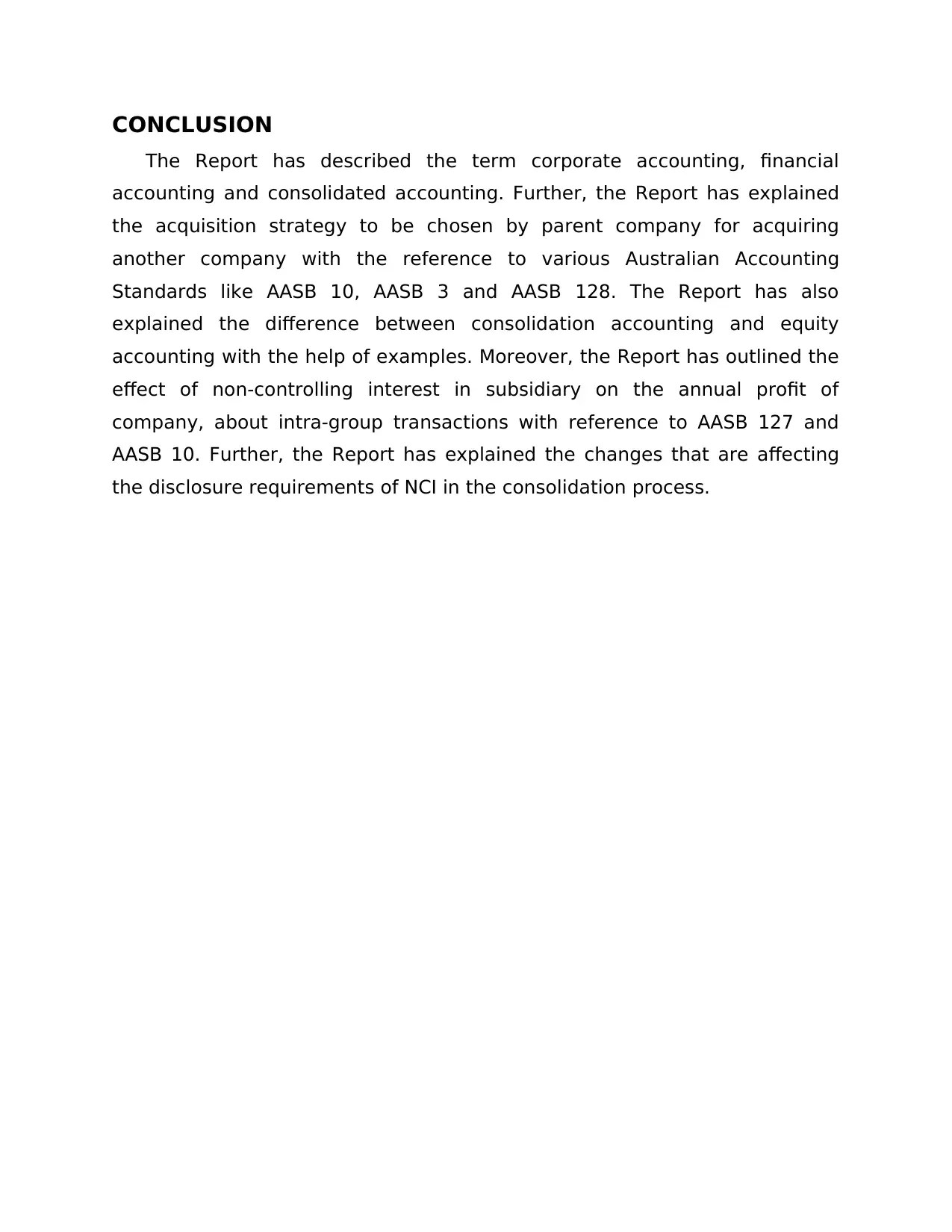
CONCLUSION
The Report has described the term corporate accounting, financial
accounting and consolidated accounting. Further, the Report has explained
the acquisition strategy to be chosen by parent company for acquiring
another company with the reference to various Australian Accounting
Standards like AASB 10, AASB 3 and AASB 128. The Report has also
explained the difference between consolidation accounting and equity
accounting with the help of examples. Moreover, the Report has outlined the
effect of non-controlling interest in subsidiary on the annual profit of
company, about intra-group transactions with reference to AASB 127 and
AASB 10. Further, the Report has explained the changes that are affecting
the disclosure requirements of NCI in the consolidation process.
The Report has described the term corporate accounting, financial
accounting and consolidated accounting. Further, the Report has explained
the acquisition strategy to be chosen by parent company for acquiring
another company with the reference to various Australian Accounting
Standards like AASB 10, AASB 3 and AASB 128. The Report has also
explained the difference between consolidation accounting and equity
accounting with the help of examples. Moreover, the Report has outlined the
effect of non-controlling interest in subsidiary on the annual profit of
company, about intra-group transactions with reference to AASB 127 and
AASB 10. Further, the Report has explained the changes that are affecting
the disclosure requirements of NCI in the consolidation process.
⊘ This is a preview!⊘
Do you want full access?
Subscribe today to unlock all pages.

Trusted by 1+ million students worldwide
1 out of 18
Related Documents
Your All-in-One AI-Powered Toolkit for Academic Success.
+13062052269
info@desklib.com
Available 24*7 on WhatsApp / Email
![[object Object]](/_next/static/media/star-bottom.7253800d.svg)
Unlock your academic potential
Copyright © 2020–2025 A2Z Services. All Rights Reserved. Developed and managed by ZUCOL.




